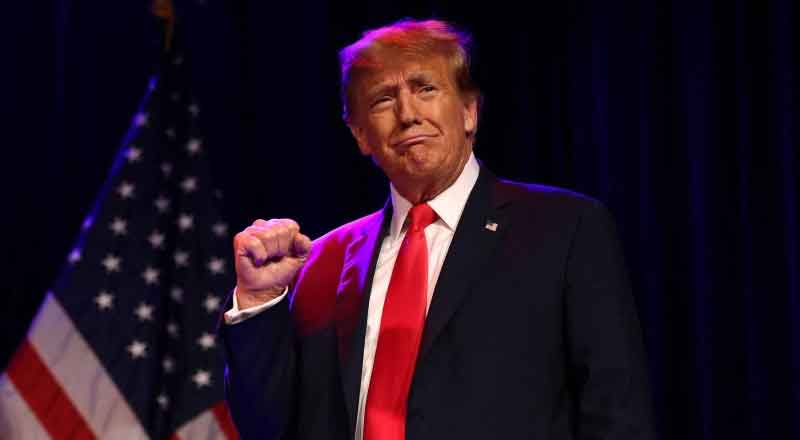President Donald Trump’s first address to a joint session of Congress since reclaiming the White House was nothing short of dramatic. Declaring that “America is back,” Trump framed his administration as ushering in a “golden age” for the nation, citing a whirlwind of executive orders and policy shifts. Yet, beyond the applause of his allies and the swift departures of his detractors, the speech painted a portrait of a deeply polarized America.
A Sweeping Agenda with a Clear Message
Trump’s address, which ran longer than any previous joint session speech, underscored his rapid-fire policy approach. He championed a series of hardline executive actions, from banning diversity, equity, and inclusion (DEI) programs to criminalizing gender-affirming care for minors. He touted his administration’s rollback of environmental and renewable energy policies, declaring a national energy emergency that experts argue is more rhetoric than reality.
Among the most controversial elements of his speech was his call for tariffs as an economic weapon. “Tariffs are about making America rich again,” Trump declared, reinforcing his belief that economic nationalism is key to prosperity. While his supporters cheered the sentiment, economists warn that trade wars could fuel inflation and hurt American consumers.
Foreign Policy: Isolationism or Strong Leadership?
Trump’s speech also marked a stark departure from traditional U.S. diplomacy. He reiterated his intention to reclaim the Panama Canal and made cryptic remarks about America’s strategic interest in Greenland. He acknowledged U.S. aid to Ukraine, earning a rare round of applause from Democrats, but also hinted at direct negotiations with Vladimir Putin. His administration’s contradictory stance on Iran—oscillating between aggression and a willingness to negotiate—left many wondering about the future of Middle Eastern diplomacy.
His comments on Afghanistan were equally striking. Trump claimed responsibility for the extradition of a suspect involved in the Abbey Gate explosion, which killed 13 American soldiers. Yet, his broader foreign policy narrative seemed focused on reducing U.S. involvement abroad while maintaining economic and military leverage.
A Deeply Divisive Social Agenda
Trump’s social policies took center stage in his address. He pushed for the criminalization of gender-affirming care for minors, cementing his administration’s hardline stance on LGBTQ+ issues. He boasted about signing an order declaring only two genders, a move that has already triggered legal challenges.
His crackdown on DEI initiatives in federal agencies and educational institutions signals a broader cultural shift, one that many conservatives welcome but critics argue is a step backward for civil rights. The swift and aggressive nature of these policies has fueled both political momentum and legal battles.
Immigration and the “Golden Card” for the Wealthy
Trump’s immigration policy took an unusual turn with his proposal of a “gold card” program for wealthy immigrants willing to invest $5 million in the U.S. While he continues to push hardline immigration policies for the general populace, this initiative suggests a preferential system favoring the affluent.
His rhetoric on immigration remained as charged as ever, with promises of further crackdowns and an emphasis on border security. Yet, the juxtaposition of fast-tracking wealthy immigrants while restricting others has drawn criticism for being both exclusionary and inconsistent with his populist messaging.
Economic Promises and Reality Checks
Trump’s speech painted a picture of an economy on the brink of resurgence, but not all indicators align with his narrative. He blamed his predecessor for an “economic catastrophe” and claimed victory over inflation, despite concerns that his tariff policies could push prices higher. He mocked Democratic opposition to his tax cuts, which analysts warn could cost the nation between $5 trillion and $11 trillion over a decade.
His assertion that America had inherited the worst inflation in history from Biden is not supported by economic data. While post-COVID inflation spiked, it had already begun to decline before Trump took office. His critics argue that his trade policies and deregulation efforts could destabilize the economy rather than strengthen it.
A Show of Power and Resistance
The political theatrics of Trump’s speech were as significant as the content itself. Republican lawmakers erupted into chants of “Fight! Fight! Fight!” at the conclusion of his address, underscoring their commitment to his agenda. Meanwhile, Democratic lawmakers filed out of the chamber, with some staging walkouts in protest.
One of the most dramatic moments occurred when Democratic Representative Al Green was forcibly removed from the chamber after interrupting Trump’s address. The incident highlighted the deep divisions that continue to define American politics under Trump’s leadership.
Elon Musk and the Battle Against Bureaucracy
Trump’s address included a rare public acknowledgment of tech billionaire Elon Musk, praising him for his work with the newly established Department of Government Efficiency. The two have found common ground in their shared disdain for government regulation, and Musk’s presence at the event symbolized the growing alignment between Trump’s administration and corporate America.
Trump’s remark that “the days of unelected bureaucrats are over” drew roaring applause from Republicans, signaling a broader push to dismantle government agencies and deregulate industries. However, critics worry that such moves could weaken essential protections for workers, the environment, and public health.
A “Golden Age” or a Nation on Edge?
Trump ended his speech with a bold proclamation: “The golden age of America has only just begun.” While his supporters see his rapid policy implementation as evidence of strong leadership, his critics warn of an administration fueled by division, rollback of civil rights, and economic uncertainty.
His first weeks back in office have been marked by sweeping executive actions, legal battles, and strained international relations. While Trump presents this as decisive leadership, the reality is a nation more divided than ever. Whether his policies will lead to prosperity or turmoil remains to be seen, but one thing is certain—America’s political landscape is set for an intense and unpredictable four years.
(With inputs from agencies)





